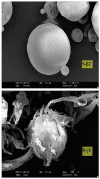A Systematic Overview of Eudragit® Based Copolymer for Smart Healthcare
- PMID: 36839910
- PMCID: PMC9962897
- DOI: 10.3390/pharmaceutics15020587
A Systematic Overview of Eudragit® Based Copolymer for Smart Healthcare
Abstract
Eudragit, synthesized by radical polymerization, is used for enteric coating, precise temporal release, and targeting the entire gastrointestinal system. Evonik Healthcare Germany offers different grades of Eudragit. The ratio of methacrylic acid to its methacrylate-based monomers used in the polymerization reaction defines the final product's characteristics and consequently its potential range of applications. Since 1953, these polymers have been made to use in a wide range of healthcare applications around the world. In this review, we reviewed the "known of knowns and known of unknowns" about Eudragit, from molecule to material design, its characterization, and its applications in healthcare.
Keywords: Eudragit classification; Eudragit synthesis; biosensor; drug delivery; nanoparticles.
Conflict of interest statement
The authors declare no conflict of interest.
Figures






















Similar articles
-
Eudragit: a technology evaluation.Expert Opin Drug Deliv. 2013 Jan;10(1):131-49. doi: 10.1517/17425247.2013.736962. Epub 2012 Oct 26. Expert Opin Drug Deliv. 2013. PMID: 23102011 Review.
-
Eudragit, a Nifty Polymer for Anticancer Preparations: A Patent Review.Recent Pat Anticancer Drug Discov. 2022;17(1):92-101. doi: 10.2174/1574892816666211013113841. Recent Pat Anticancer Drug Discov. 2022. PMID: 34645379 Review.
-
Expedition of Eudragit® Polymers in the Development of Novel Drug Delivery Systems.Curr Drug Deliv. 2020;17(6):448-469. doi: 10.2174/1567201817666200512093639. Curr Drug Deliv. 2020. PMID: 32394836 Review.
-
Moisture sorption by polymeric excipients commonly used in amorphous solid dispersions and its effect on glass transition temperature: III. Methacrylic acid-methyl methacrylate and related copolymers (Eudragit®).Int J Pharm. 2023 Apr 5;636:122745. doi: 10.1016/j.ijpharm.2023.122745. Epub 2023 Feb 21. Int J Pharm. 2023. PMID: 36822340
-
Eudragit®-S100 Coated PLGA Nanoparticles for Colon Targeting of Etoricoxib: Optimization and Pharmacokinetic Assessments in Healthy Human Volunteers.Int J Nanomedicine. 2020 Jun 8;15:3965-3980. doi: 10.2147/IJN.S244124. eCollection 2020. Int J Nanomedicine. 2020. PMID: 32606658 Free PMC article. Clinical Trial.
Cited by
-
Optimization of Eudragit RS100 Nanocapsule Formulation for Encapsulating Perillyl Alcohol and Temozolomide Using Design of Experiments.ACS Nanosci Au. 2025 Jan 29;5(2):70-83. doi: 10.1021/acsnanoscienceau.4c00057. eCollection 2025 Apr 16. ACS Nanosci Au. 2025. PMID: 40255977 Free PMC article.
-
Surviving process and transit: Controlled freeze drying, storage and enteric coated capsules for targeted delivery of probiotic Lactobacillusacidophilus.Heliyon. 2024 Mar 20;10(7):e28407. doi: 10.1016/j.heliyon.2024.e28407. eCollection 2024 Apr 15. Heliyon. 2024. PMID: 38560212 Free PMC article.
-
Biocompatible Poly(acrylic acid-co-methacrylic acid)-Coated Iron Oxide Nanoparticles for Enhanced Adsorption and Antimicrobial Activity of Lasioglossin-III.ACS Appl Mater Interfaces. 2025 Mar 19;17(11):16644-16657. doi: 10.1021/acsami.4c22603. Epub 2025 Mar 5. ACS Appl Mater Interfaces. 2025. PMID: 40042293 Free PMC article.
-
Significantly Increased Aqueous Solubility of Piperine via Nanoparticle Formulation Serves as the Most Critical Factor for Its Brain Uptake Enhancement.Int J Nanomedicine. 2025 Mar 30;20:3945-3959. doi: 10.2147/IJN.S506827. eCollection 2025. Int J Nanomedicine. 2025. PMID: 40181831 Free PMC article.
-
Development of a pH Gradient Dissolution Condition to Predict the Behavior of Delayed Release Formulations under Fed In Vivo Condition.AAPS PharmSciTech. 2025 Aug 11;26(7):211. doi: 10.1208/s12249-025-03186-5. AAPS PharmSciTech. 2025. PMID: 40790009
References
-
- Shah H., Jain A., Laghate G., Prabhudesai D. Remington: The Science and Practice of Pharmacy. Academic Press; Cambridge, MA, USA: 2020. Pharmaceutical Excipients; pp. 633–643. - DOI
-
- Patra C.N., Priya R., Swain S., Kumar Jena G., Panigrahi K.C., Ghose D. Pharmaceutical Significance of Eudragit: A Review. Futur. J. Pharm. Sci. 2017;3:33–45. doi: 10.1016/j.fjps.2017.02.001. - DOI
-
- Wen H., Park K. Oral Controlled Release Formulation Design and Drug Delivery: Theory to Practice. John Wiley & Sons; Hoboken, NJ, USA: 2010. - DOI
Publication types
LinkOut - more resources
Full Text Sources
Other Literature Sources

